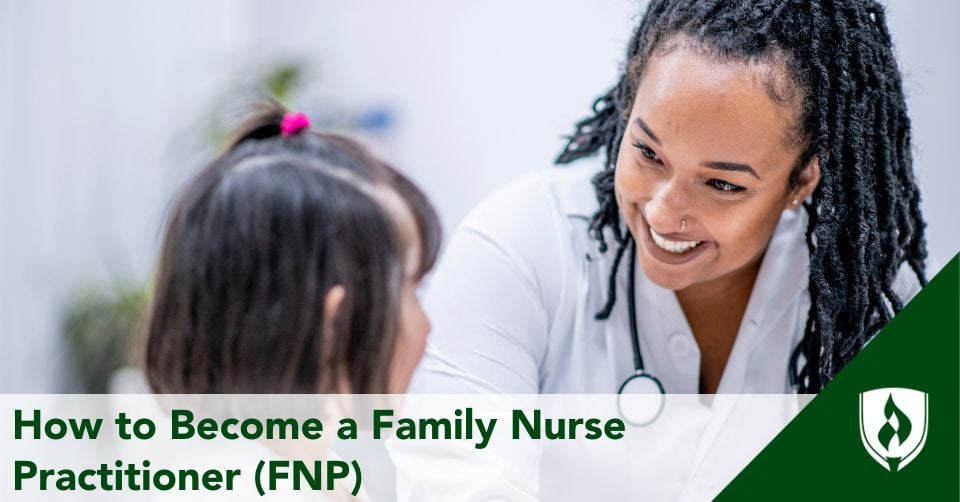How to Become a Family Nurse Practitioner and Gain Time With Your Patients
By Brianna Flavin on 09/26/2024

A career in patient care can take you to any number of healthcare settings—from primary care offices to hospitals and so many places in between. But the role you have with patients will vary greatly depending on the path you choose.
Many nurses come to the field of nursing out of a desire to truly help people. And the field of nursing often includes holistic aspects of patient care, such as compassion, understanding familial and community networks, lifestyle education, emotional well-being and establishing trust in the patient care environment.
But that doesn't mean nurses always get to give the kind of care they prefer. When healthcare facilities are running on fewer nurses than they need, or when shifts get long and the demands of the workday overshadow the joy of making a difference in the world, nursing can be hard on your heart.
One of the best things about nursing, though, is how it encompasses so many different kinds of work. And if you're the kind of person who would prefer to take more time with each patient in non-emergency situations, working as a family nurse practitioner (FNP) could be just what you're looking for.
Nurse practitioners enjoy more autonomy over their career than the average nurse, and family nurse practitioners usually have a consistent schedule where they can build longer relationships with their patients. That's attractive to many nurses! These specialists represent more than 70% of all licensed nurse practitioners within the United States.1
Healthcare has many different areas of profound shortage. And advanced practice registered nurses (APRNs) help address some of the most critical shortages out there. Family nurse practitioners work in many places as a primary care provider, helping to meet needs in communities where doctors or larger healthcare systems are hard to access.
If you’re here, you probably already know that family nurse practitioners have an amazing role. So, what would it take to get into that role? Read on for a full breakdown!
The foundational knowledge family nurse practitioners need
This type of advanced practice registered nurse, like all APRN roles, requires advanced education. This is important since family nurse practitioners—have broader duties and more autonomy than registered nurses (RNs).
Most family nurse practitioners work in primary care at a clinic. (Though they can work in a variety of places, like a women's health center or community health centers.) FNPs provide health care services for patients and families throughout the entire lifespan. A patient can see an FNP for many of the same concerns primary care physicians handle.
As an FNP, you could conduct annual physical exams, prescribe medications (depending on where you are located) and perform well-child exams.1 As you can imagine, the medical knowledge you need for that takes some time to learn. And it all starts with the right education.
Step 1: Choose the right type of BSN program for your situation
There are plenty of great associate degree programs that can help you become a nurse. Some nurses start with this kind of degree, then decide later on that they'd like to get into advanced practice nursing.
Whether that's you—or if you're starting from square one—you'll need a Bachelor of Science in Nursing (BSN) to become an FNP.
Skip down to section that applies to your current situation.
If you have a bachelor's degree in another field
Nursing education has accelerated BSN second degree programs, sometimes called “A-BSN." Look for these if you have a non-nursing Bachelor’s degree and want to earn your BSN.
Rather than starting from the ground up—like you would in a BSN standard degree program—an accelerated BSN degree is designed to help you save time.
Rasmussen’s accelerated BSN second degree program can be completed in as few as 18 months.2
If you have a practical nursing degree
Licensed practical nurses (LPNs) and other vocational nurses can find BSN programs made for nurses. These programs assume you already have nursing experience, and they build on what you know to get you to the full bachelor's degree level.
These programs are often called "bridge" programs. If this is your situation, request more information about the LPN bridge program on Rasmussen's practical nursing degree page.
If you have your registered nursing license
If you are already an RN, you know most of the hands-on skills BSN nurses learn. So choose a program that takes your experience into account.
Many universities offer RN to BSN programs to cater to nurses who've decided they want to return to school for their BSN degree. Rasmussen’s online RN to BSN program, for instance, can be completed in as few as 12-18 months.2
If you don't have a college degree yet
If the above scenarios don't apply to you, a standard bachelor of science in nursing program is your best bet to begin your journey toward becoming a family nurse practitioner!
Quality BSN programs take a comprehensive approach to nursing education. Students can expect to learn...
- Professional Nursing Skills
- Integration of Genetics and Genomics into Ethical Nursing Practice
- Emerging Healthcare Technologies and Innovation
- And much more! (Check out 7 BSN Courses to Expect During Your Nursing Education Journey)
BSN programs will also include clinical practice hours where students practice what they've learned in real healthcare facilities, under the supervision of professional nurses. Clinical hours provide a hands-on learning experience that simply can’t be replicated within the confines of a classroom.
Step 2: Obtain RN licensure
To become a family nurse practitioner, you will need both an RN license and a BSN degree. That means, if you’re new to the nursing field, the most practical route to take would be to enroll in a BSN standard degree program, which will also help you reach RN licensure.
If you are not already an RN, then your BSN program will help you meet all the requirements necessary to take the NCLEX-RN® exam after you graduate. Actually getting your registered nursing license involves applying for it through your state's nursing board website, paying any necessary fees and passing the NCLEX® exam.
More on that here! What Is the NCLEX? What You Need to Know About This Key Nursing Exam
Step 3: Complete an MSN-NP program
Family nurse practitioners must first complete a Nurse Practitioner Master of Science in Nursing (MSN-NP) program.
An MSN-NP is a graduate nursing degree designed for nurses who want to advance in their clinical practice (as opposed to other focus areas like nursing leadership, administration or policy).
Also, each state sets its own education requirements for advanced practice nurses. In general, APRNs must graduate from accredited Master’s degree programs, but to get all the specifics, make sure you check with your state's board of nursing to have clarity on all the requirements you need to meet.
Rasmussen University’s MSN Nurse Practitioner program is accredited by the Commission on Collegiate Nursing Education (CCNE). Our online MSN-NP program includes a Family Nurse Practitioner (FNP) degree specialization track to provide students with specified knowledge family nurse practitioners need.
Rasmussen’s MSN-NP can be completed in as few as 27 months.2
Step 4: Pass the Family Nurse Practitioner certification exam
“To become licensed and use the APRN title, most states require national certification,” the Bureau of Labor Statistics explains.1
There are two certification issuing bodies through which eligible nurses may take the national FNP certification exam: the American Academy of Nurse Practitioners Certification Board (AANPCB) and the American Nurses Credentialing Center® (ANCC).
Once you pass the AANPCB Family Nurse Practitioner (FNP) exam you are awarded the FNP-C credential. Once you pass the ANCC® Family Nurse Practitioner (FNP) board certification exam you are awarded the FNP-BC™ credential.
What is the difference between the AANPCB and ANCC family nurse practitioner exams?
The American Academy of Nurse Practitioners (AANPCB) describes its family nurse practitioner certification exam (FNP-C) as, “an entry-level competency-based examination that tests clinical knowledge in family/individual across the life span.”3 This exam consists of 150 questions—of which only 135 are scored—that cover the following knowledge areas:
- Health assessment
- Pathophysiology
- Therapeutics
- Evidence-informed practice
The AANPCB certification exam also tests nurses’ abilities to assess, diagnose, plan and evaluate patients across all ages. The FNP-C credential is more for those who wish to focus on patient/clinical care.3,5
Alternatively, there’s the Family Nurse Practitioner Certification (FNP-BC™) exam offered through the American Nurses Credentialing Center (ANCC). The ANCC certification exam is also a competency-based examination to verify the skills and clinical knowledge FNPs need.
The ANCC certification exam consists of five categories.
- Assessment
- Diagnosis
- Planning
- Implementation
- Evaluation
Within these categories, questions cover various body systems, drug agents and age groups. There are 175 total test questions, though only 150 are scored. The FNP-BC™ credential covers clinical care, but also has added planning content. It is for those who wish to extend their focus to leadership opportunities.4,5
FNP certifications awarded through both the AANPCB and the ANCC renewed every five years.3,4
Is becoming a family nurse practitioner worth it?
A career as an FNP takes some investment. And only you can decide if that investment is worthwhile.
Whether they work in physicians’ offices, hospitals, outpatient care centers or their own private practices, family nurse practitioners have a tremendous impact on the patients and families they see.
Plus, the future looks bright for these healthcare professionals! According to projections from the Bureau of Labor Statistics, nurse practitioner roles are projected to increase by 40% between 2023 and 2033.6
If you really love the idea of working in primary care and helping patients navigate changes in their health and their lives as they grow, the time it takes to get there will be more worthwhile.
Now that you know how to become a family nurse practitioner, there’s just one question left—are you ready to start working towards it?
See what an MSN-NP degree would look like and get all the details about tuition, timing and more at Rasmussen University’s MSN Nurse Practitioner degree page.
Rasmussen University’s MSN Nurse Practitioner program and its specializations are not available to residents of all states. It is important to speak with an Admissions Advisor to determine your eligibility for enrollment. The MSN Nurse Practitioner programs at Rasmussen University are currently NOT eligible for participation in Title IV federal aid programs.
FNP-BC™ is a trademark of American Nurses Credentialing Center
ANCC® is a registered trademark of American Nurses Credentialing Center
American Nurses Credentialing Center® is a registered trademark of American Nurses Credentialing Center
NCLEX® is a registered trademark of National Council of State Boards of Nursing, Inc.
1 Bureau of Labor Statistics, U.S. Department of Labor, Occupational Outlook Handbook, Nurse Anesthetists, Nurse Midwives, and Nurse Practitioners, (accessed July 19, 2024), https://www.bls.gov/ooh/healthcare/nurse-anesthetists-nurse-midwives-and-nurse-practitioners.htm#tab-4
2 Completion time is dependent on transfer credits accepted and the number of courses completed each term.
3 American Academy of Nurse Practitioners Certification Board, Family Nurse Practitioner (FNP), (accessed July 19, 2024), https://www.aanpcert.org/certs/fnp
4 American Nurses Credentialing Center, Test Content Outline, (accessed July 2024), https://www.nursingworld.org/~4a312f/globalassets/certification/certification-specialty-pages/resources/test-content-outlines/ancc-22-fnp-tco-2021-final-for-web-posting_updated-08122022.pdf
5 Meg Lambrych, FNP-BC vs. FNP-C: Learn the Difference Between These Nurse Practitioner Certifications,(Jun.11, 2024), https://nursejournal.org/resources/fnp-bc-vs-fnp-c/
6 Bureau of Labor Statistics, U.S. Department of Labor, Occupational Outlook Handbook, Nurse Anesthetists, Nurse Midwives, and Nurse Practitioners, (accessed July 19, 2024), https://www.bls.gov/ooh/healthcare/nurse-anesthetists-nurse-midwives-and-nurse-practitioners.htm#tab-6

